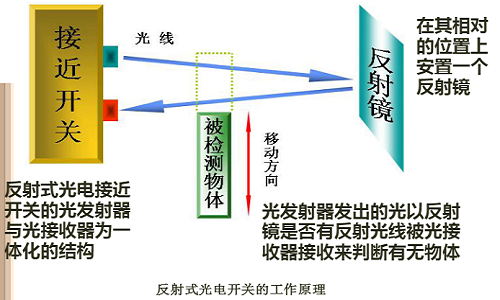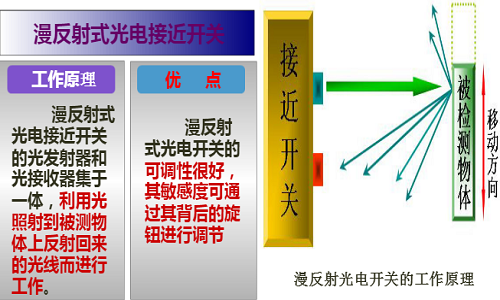

A photoelectric sensor is a device that converts light signals into electrical signals. Its working principle is based on the photoelectric effect. The photoelectric effect refers to the phenomenon where electrons in certain materials absorb the energy of photons when light is incident on them, resulting in corresponding electrical effects.




In through-beam photoelectric sensors, the emitter and receiver are aligned in opposite directions. The advantage of this setup is that the light beam directly reaches the receiver, allowing for long detection distances and high excess gain. These sensors can reliably detect almost any object. The incident angle, surface characteristics, object color, etc., do not affect the reliability of the sensor.


The emitter and receiver are aligned within the housing, making the reflective type photoelectric sensor easy to install. Simply place the reflector on the opposite side and align the sensor with it. Standard models with polarizing filters combine the installation advantages of the reflector system with reliable detection performance. Even reflective objects can be detected at a considerable distance. Reflective type photoelectric sensors can detect transparent objects, making them an ideal choice for reliably detecting transparent materials.


Diffuse reflective photoelectric sensors are particularly easy to install because only one device needs to be installed without a reflector. These sensors primarily operate at short distances, providing optimal switching accuracy and can reliably detect very small objects. Sensors with background suppression can only detect specific areas in front of the sensor. Any objects outside this area will be ignored. Sensors with background suppression are insensitive to interfering objects in the background, ensuring detection accuracy even in the presence of interference. Sensors with background analysis are always used in applications with a fixed background within the measurement range and can be used to calibrate the sensor.


(1) Non-Contact Detection
Detection can be performed without contacting the object, thus preventing scratches on the detected object. Additionally, the sensor itself will not be damaged, resulting in a longer lifespan and no need for maintenance.
(2) Can Detect Most Objects
Detection is based on the surface reflection or light-blocking amount of the object, allowing for the detection of most objects (glass, metal, plastic, wood, liquid, etc.).
(3) Long Detection Distance
Photoelectric sensors generally have high power, allowing for long-distance detection.
WeChat graphic materials are sourced from the internet or other public accounts, copyright belongs to the original author only, for reference and learning purposes!

Phone: 0431—81970000
Official Website: www.ccostm.com
Address: 1666 Yongshun Road, Jingyue National High-tech Industrial Development Zone, Changchun City, Jilin Province

Long press the fingerprint > Scan the QR code in the image > Add follow